Physical Address
304 North Cardinal St.
Dorchester Center, MA 02124
Tube thoracostomy is a procedure used to evacuate an abnormal accumulation of fluid or air from the pleural space and can be performed on an elective, urgent, or emergent basis. Air or fluid can accumulate in the pleural space as a result of spontaneous or traumatic pneumothorax, pleural fluid accumulation of blood, malignancy, infection (empyema), or lymph (chylothorax). The first modern methods to evacuate the contents of the pleural space were developed in the 19th century, but these techniques did not become widespread until 1918, when they were used to treat postinfluenza empyema. Military experience demonstrated that thoracic drainage combined with antiseptics and antibiotics reduced mortality related to thoracic trauma from 62.5% during the Civil War, to 24.6% in World War I, and to 12% in World War II.
The lung is surrounded by two layers, the parietal pleura, which lines the interior of the chest wall, and the visceral pleura, which covers the lungs. They are separated by a potential space that usually contains a thin layer of fluid that lubricates the pleural space . A small negative pressure within the pleural space helps keeps the lung inflated and the two layers closely apposed. With inspiration, chest expansion increases negative intrathoracic pressure and leads to inflation of the lung from an influx of air. If the pleural space is disrupted, air, blood, or other fluid can accumulate between the two layers of the pleura. The result is that the pressure gradient associated with normal respiration is compromised and can lead to “collapse” of the lung. As the amount of fluid or air increases, respiratory function worsens leading to symptoms of dyspnea, often with pleuritic chest pain and anxiety. The degree of respiratory compromise depends on the volume of fluid or air in the pleural space, the patient's age, baseline pulmonary status, and the integrity of the chest wall. In severe cases, a one-way valve type of mechanism can occur within the respiratory apparatus, leading to tension pneumothorax physiology. The hallmark of tension pneumothorax is a progressive accumulation of air in the pleural space with each breath that will result in severe respiratory dysfunction, cardiovascular compromise, and ultimately obstructive shock if untreated.
A pneumothorax is caused by the presence of air in the pleural space and loss of the normal negative pressure ( Fig. 10.1 ). Air can enter the pleural space from outside of the chest wall as a result of a penetrating injury. Air can also enter internally from a ruptured lung bleb or damaged trachea. Iatrogenic injuries can occur from needle procedures such as subclavian venous cannulation, transthoracic biopsy, thoracentesis, positive pressure ventilation (PPV), or cardiopulmonary resuscitation ( Fig. 10.2 ).
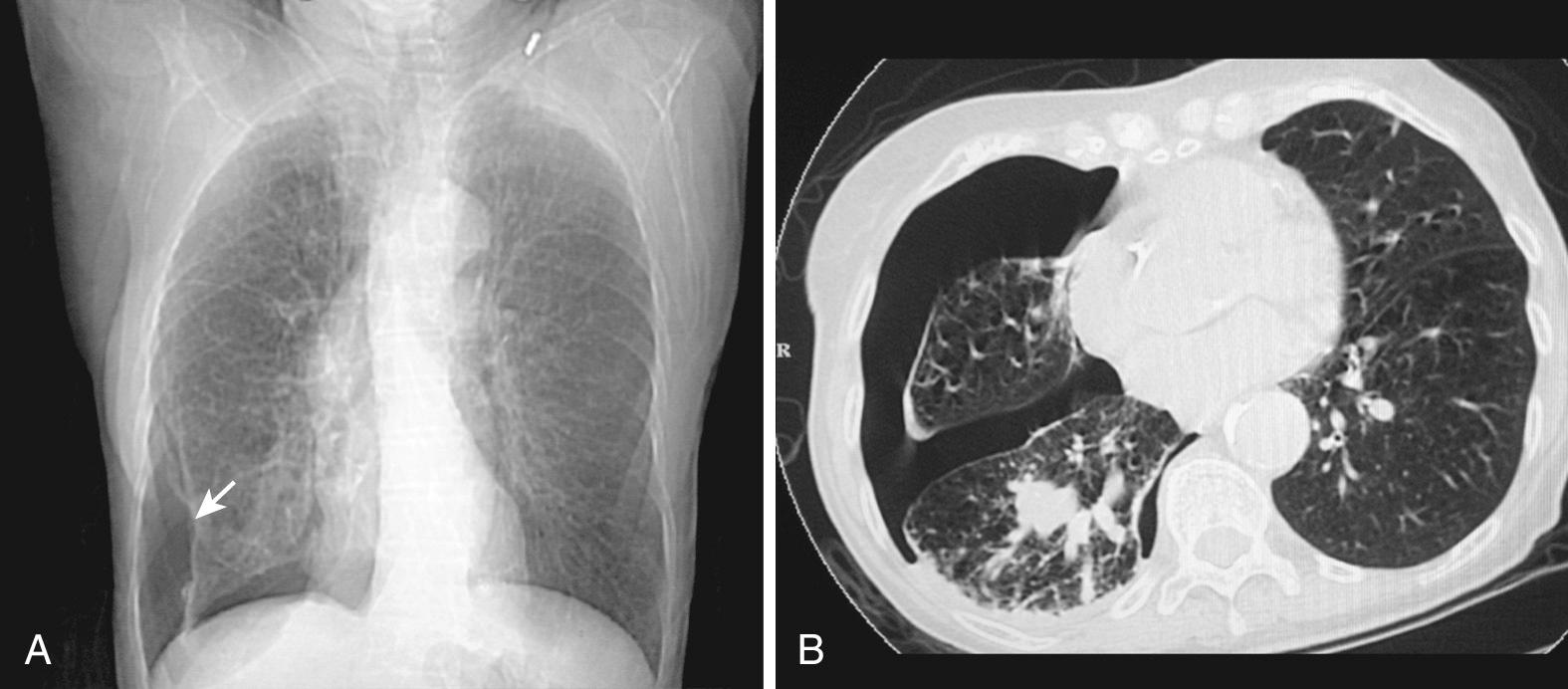
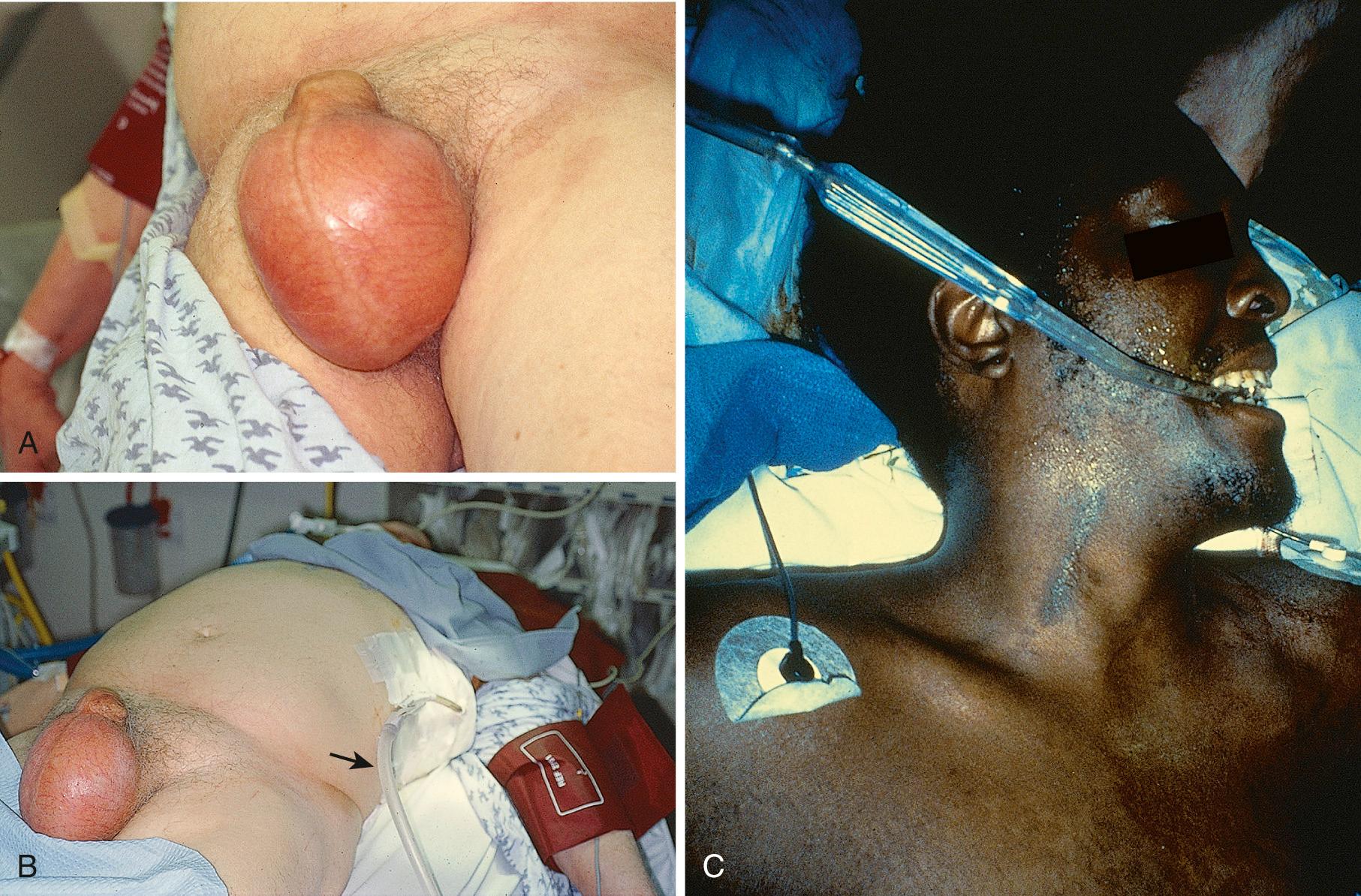
Pneumothoraces are commonly divided into “open” and “closed.” An open pneumothorax indicates that the skin and underlying soft tissue sustained an injury that penetrated into the pleural space.
Spontaneous pneumothorax is caused by the rupture of a subpleural lung bleb with little or no trauma and can be categorized as either primary or secondary based on the presence of underlying lung disease. Primary spontaneous pneumothorax occurs in a patient without overt lung disease. The typical patient with spontaneous pneumothorax is a tall, thin, 20- to 40-year-old male smoker ( Fig. 10.3 ). Secondary spontaneous pneumothoraces occur in patients with underlying lung or pleural disease, including emphysema, chronic bronchitis, asthma, Marfan's syndrome, infection, and neoplasm. The morbidity, mortality, and long-term complications associated with pneumothorax increase in patients with underlying lung disease. Whereas a primary pneumothorax may be managed by selective observation or might simply be aspirated, a secondary pneumothorax often requires a more aggressive management approach.
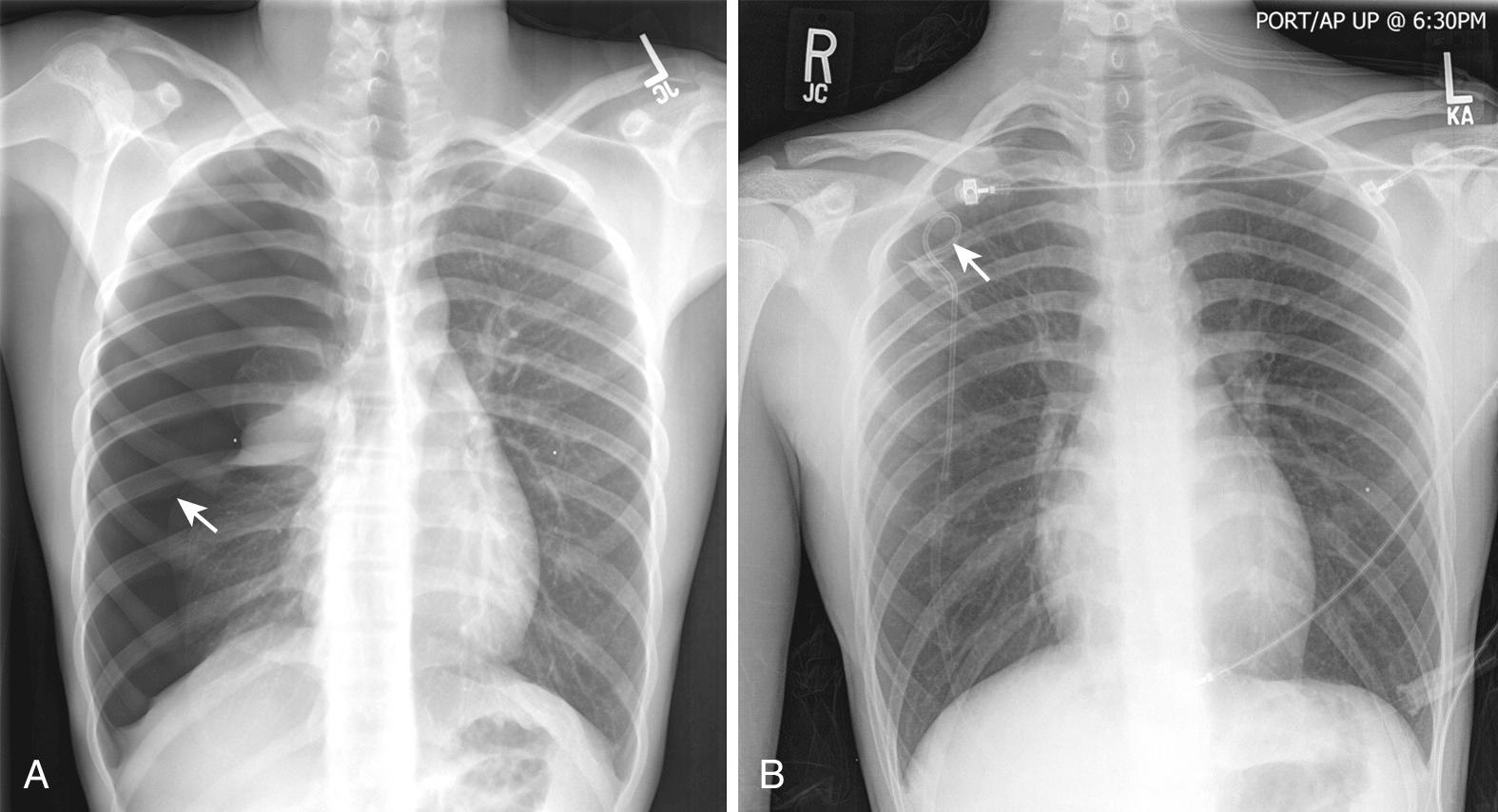
The sudden onset of pleuritic chest pain and dyspnea with exertion or at rest is the most common finding. More subtle manifestations may also occur with little or no pain and only mild dyspnea on excursion that the patient may ignore for days. A person with a small spontaneous pneumothorax may never seek medical attention, and the process will resolve without treatment. The signs and symptoms do not always correlate well with the size or cause of the collapsed lung. Tube thoracostomy is the most common treatment, but new trials suggest that conservative management or aspiration of first-time primary pneumothoraces results in similar outcomes as traditional tube thoracostomy, though with fewer complications, shorter hospital stay, and lower cost. Depending on the size of the pneumothorax, conservative management and aspiration are both reasonable initial interventions in clinically stable patients. However, to date no high-quality clinical trials have definitely demonstrated that aspiration is a superior treatment methodology. Rarely, spontaneous pneumothorax may be bilateral. In addition, in rare cases, a spontaneous pneumothorax may progress to tension pneumothorax as described previously, which can result in a potentially life-threatening condition.
Closed pneumothorax usually occurs from a rib fracture that penetrates the lung, but can also occur when an alveolus or bleb ruptures after blunt trauma. The air leak from a closed pneumothorax is generally self-limited but can, in rare cases, progress to a tension pneumothorax.
An open pneumothorax occurs when the chest wall is penetrated and the negative intrapleural pressure is lost. Each breath can increase intrapleural pressure, especially if the diameter of the chest wound is greater than the diameter of the trachea. With each respiratory attempt, air moves preferentially through the chest wall opening rather than down the trachea and thus prevents meaningful ventilation of the involved lung.
An open pneumothorax can occasionally manifest as a tension pneumothorax, which is a life-threatening condition that requires immediate intervention. A tension pneumothorax occurs when an injury creates a one-way “flap valve” mechanism that allows air into the pleural space with inspiration but then closes with expiration and traps the air ( Fig. 10.4 ). The progressive accumulation of air in the pleural space leads to ipsilateral complete lung collapse and then impingement on the mediastinum with a shift of the heart toward the uninvolved side. This restricts ventricular filling and subsequently decreases cardiac output. This severe disruption in both respiratory and cardiac function can lead to hypotension and reduced ventilation (both hypoxia and CO 2 retention) and eventually to cardiopulmonary collapse.
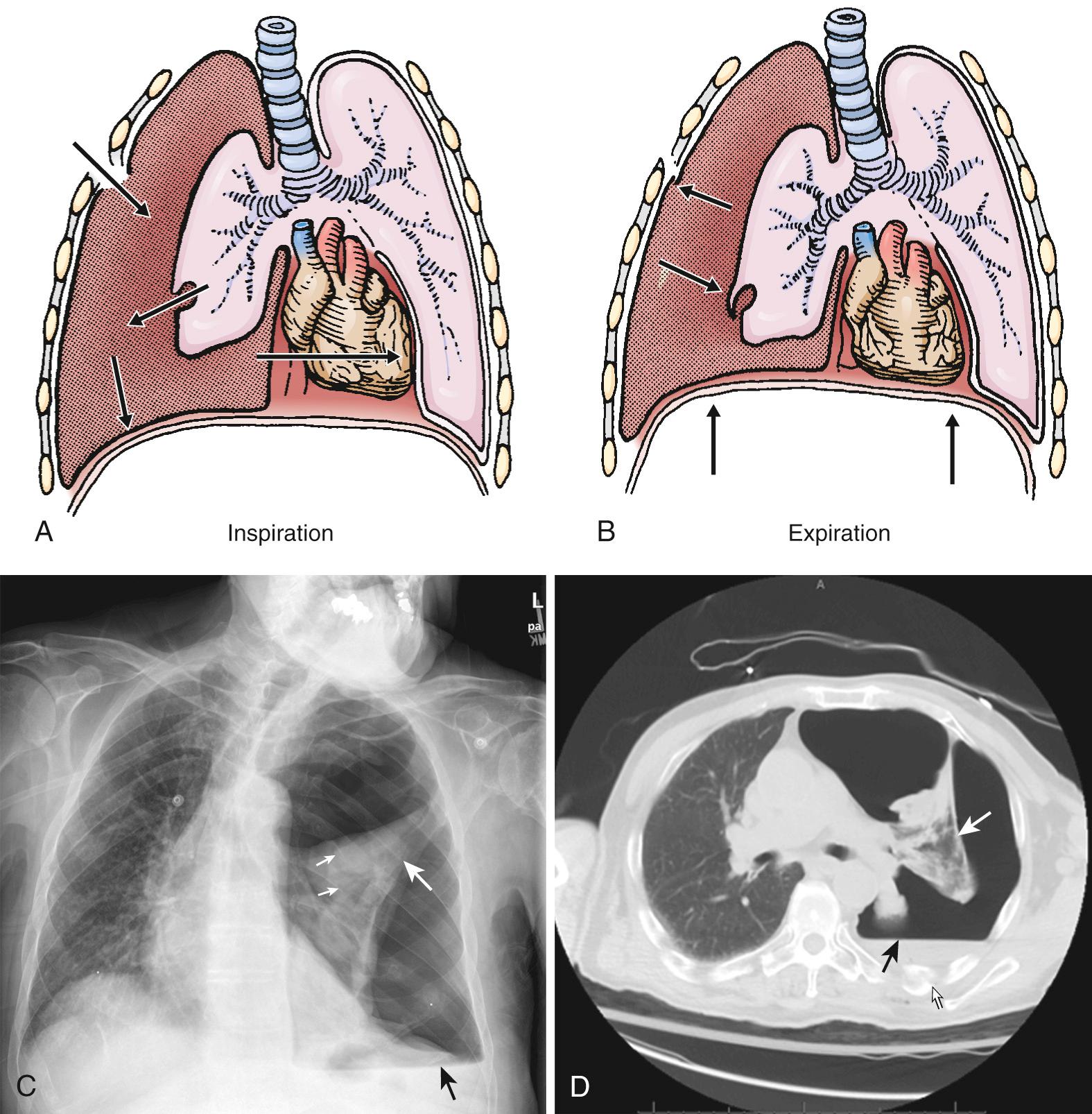
A tension pneumothorax is usually caused by penetrating chest injuries but can also result from fracture of the trachea or bronchi, a ruptured esophagus, the presence of an occlusive dressing over an open pneumothorax, and PPV. Patients with chest or lung injuries who are treated with PPV are at much greater risk for the development of a tension pneumothorax. Consequently, any patient with a penetrating thoracic injury (even without immediate evidence of a hemothorax or pneumothorax) should be considered for a “prophylactic” chest tube before mechanical ventilation. A pneumothorax may also develop in patients with asthma or emphysema from the high pressure required for ventilation, which can also lead to a tension pneumothorax.
Hemothorax is an accumulation of blood in the pleural space as a result of injury to the heart, great vessels, or vessels of the lungs, mediastinum, or chest wall. Bleeding from the lung parenchyma is usually low pressure, self-limited, and ceases when a chest tube is inserted. However bleeding from an intercostal artery, a pulmonary artery, or the internal mammary artery can be profuse and often requires surgical intervention.
An empyema is an accumulation of pus in the pleural space, usually from a parapneumonic infectious effusion ( Fig. 10.5 ). An empyema can also be caused by violation of the thoracic space during surgical procedures (e.g., tube thoracostomy), trauma, and esophageal perforation. Pleural infection rates have increased 3% per year in the United States in the last 2 decades. The bacteriology of pleural infections is commonly classified as either community or hospital acquired. Nearly 60% of cases of community-acquired empyema are caused by Streptococcus pneumoniae species, whereas Staphylococcus species account for nearly 45% of hospital-acquired infections.
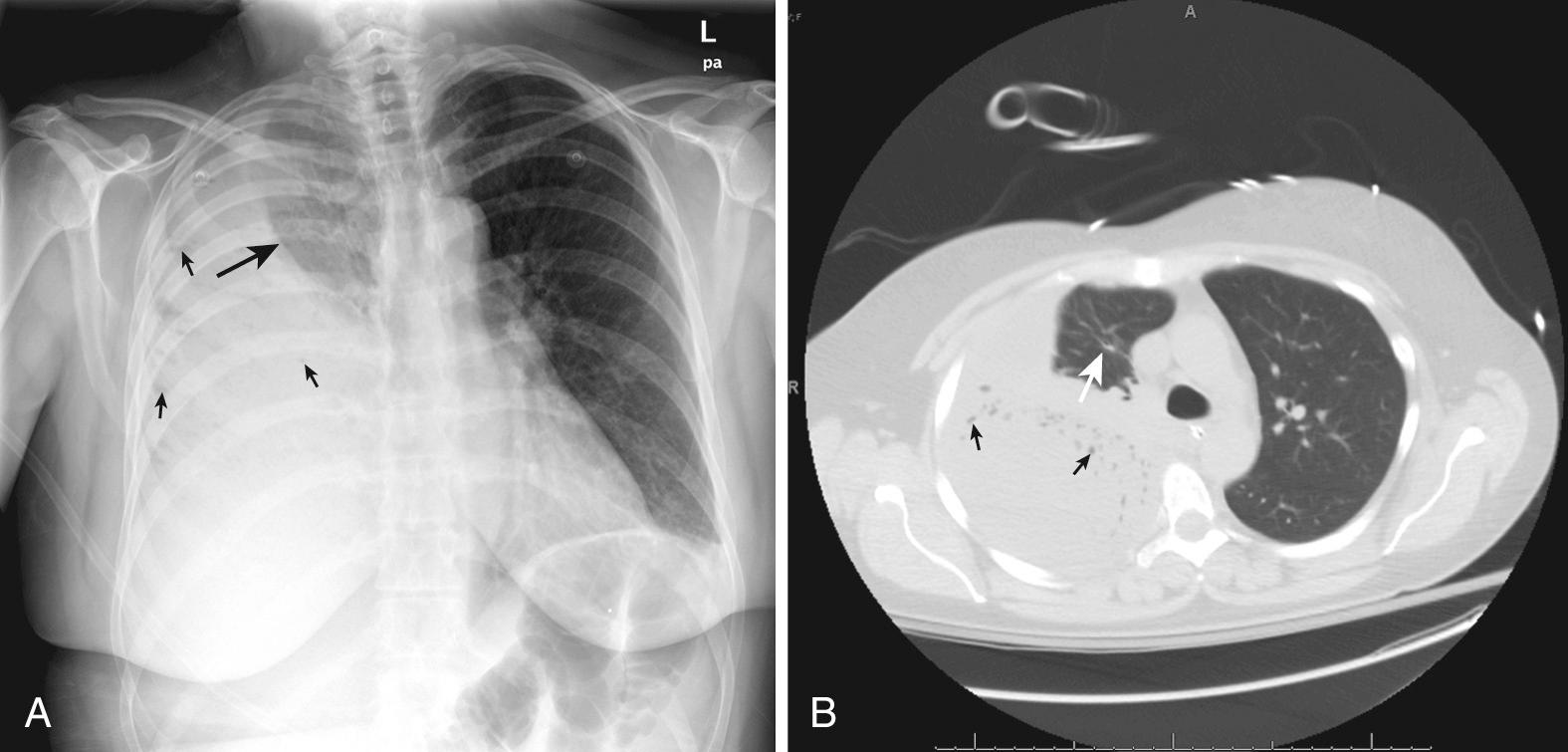
Chylothorax results from injury to the thoracic duct during placement of a central line, operative injury, or chest trauma. Primary thoracic duct injury is usually asymptomatic because the chyle initially collects extrapleurally and may not begin to fill the pleural cavity for 2 to 10 days. As the fluid accumulates, respiratory symptoms slowly develop. The chest radiograph demonstrates a pleural effusion, and the diagnosis is made when thoracentesis reveals a milky fluid with a high fat and lymphocyte content and 4 to 5 g/dL of protein. Definitive treatment is either repeated thoracentesis or tube thoracostomy combined with parenteral alimentation until the volume of chyle decreases.
The symptoms of patients with abnormal collections in the pleural space range widely depending on the size of the pneumothorax, the rapidity of accumulation, the age of the patient, and the presence of comorbities, especially underlying lung disease. Specific symptoms range from mild dyspnea with exertion and pleuritic chest pain with small disruptions to hypotension or severe dyspnea, especially in those patients with tension pneumothorax. With a spontaneous pneumothorax, 95% of patients complain of the sudden onset of sharp, pleuritic chest pain, shoulder pain, or both. Sixty percent of patients experience dyspnea, and 12% have a mild cough. Dyspnea and anxiety are more common in older patients.
Tension pneumothorax (TP) must be considered in any patient with sudden or severe respiratory or cardiac deterioration and in intubated patients who become difficult to ventilate. Signs of TP include increased airway pressure, hypotension, or elevated central venous and pulmonary artery pressure. Severe dyspnea, restlessness, agitation, and a feeling of impending doom can develop rapidly in conscious patients with tension pneumothorax. Initially these patients may be tachycardic and tachypneic but can quickly become hypotensive.
The symptoms of hemothorax can be similar to those of pneumothorax but may be accompanied by hypotension as blood accumulates in the pleural space. The onset of symptoms with effusions is usually much more gradual, with increasing shortness of breath and dyspnea on exertion occurring over a period of days to weeks.
During the initial phase of resuscitation (airway, breathing, circulation, disability), consider the diagnosis of pneumothorax in patients who are tachycardic, hypotensive, and dyspneic. These symptoms are not specific as similar ones do occur with pulmonary embolism, pericardial tamponade, large pleural effusion, and severe, multilobar pneumonia. Serial examination is critical as the diagnosis of tension pneumothorax by physical examination can be very subtle. Use the phrase “look, listen, and feel” as your guideline. Observe the chest wall, which may reveal asymmetric chest expansion, and the neck and forehead veins, which may be distended, even if the patient is hypotensive. The trachea may be deviated away from the side of the pneumothorax. When percussing the chest wall, hyperresonance on the affected side and subcutaneous emphysema may be present. Auscultation may demonstrate diminished breath sounds on the injured side. In one prospective study, the sensitivity, specificity, and diagnostic accuracy of auscultation for hemothorax and pneumothorax were 84%, 97%, and 89%, respectively. A false-negative auscultation is more likely than a false-positive one. Pulsus paradoxus may be evident. For intubated patients, an early sign of tension pneumothorax is difficulty ventilating because of increased airway pressure. Additionally, poor compliance may be noted when providing respiratory support by bagging.
In injured patients with apnea, hypotension, or cardiopulmonary arrest, diagnose and treat a tension pneumothorax by immediate needle or catheter decompression thoracentesis. In patients who may have TP, do not take the time to obtain and review a radiograph because delay can lead to increased morbidity and mortality in patients with this emergency condition. X-rays cause a delay in therapeutic intervention. Confirm the diagnosis of tension pneumothorax after needle decompression by rapid improvement in vital signs and a rush of air through the needle.
In more stable patients (and those with smaller accumulations) the findings on physical examination are less sensitive, and a chest radiograph, ultrasound, or even a computed tomography (CT) scan is usually necessary to make a definitive diagnosis. Physical findings may include unilaterally decreased breath sounds, tachypnea, tachycardia, decreased tactile fremitus, increased resonance with percussion, or subcutaneous emphysema. Alternatively, the examination may reveal little to no abnormalities with a small pneumothorax. Patients with a pneumothorax involving less than 20% of the hemithorax will often have completely normal findings on chest examination, including equal breath sounds ( Fig. 10.6 ). Pleural fluid collections are difficult to detect by physical examination, particularly with less than 500 mL of fluid in the pleural space. Breath sounds may be decreased and percussion of the bases may be dull.
![Figure 10.6, Smaller pneumothoraces such as this (note the faintly visible pleural reflection [arrow], absence of lung markings at the left apex, and relative crowding of vessels at the left hilum) can be difficult to see on radiographs and even harder—if not impossible—to appreciate on physical examination. Patients with a pneumothorax of less than 20% will often have completely normal findings on chest examination, including equal breath sounds. Figure 10.6, Smaller pneumothoraces such as this (note the faintly visible pleural reflection [arrow], absence of lung markings at the left apex, and relative crowding of vessels at the left hilum) can be difficult to see on radiographs and even harder—if not impossible—to appreciate on physical examination. Patients with a pneumothorax of less than 20% will often have completely normal findings on chest examination, including equal breath sounds.](https://storage.googleapis.com/dl.dentistrykey.com/clinical/TubeThoracostomy/5_3s20B9780323354783000105.jpg)
Parapneumonic empyemas are often accompanied by fever, cough, chest pain, dyspnea, and purulent sputum (see Fig. 10.5 ). Physical examination may reveal diminished breath sounds, dullness on percussion, egophony, and diminished tactile fremitus on the involved side. Fever will often develop in patients with an indwelling chest tube and empyema. The pleural fluid drainage may be copious and purulent, and respiratory symptoms may worsen.
In stable patients, a chest radiograph is an essential tool for diagnosing a pneumothorax. In unstable patients with a potential tension pneumothorax, the diagnosis should be made clinically, but in rare cases a portable radiograph may be obtained in the resuscitation room if the patient is being carefully monitored by a clinician. As will be discussed later in this chapter, bedside ultrasound may prove advantageous as a diagnostic modality in these peri-stable patients. The best plain radiographs for detecting hemothorax or pneumothorax are traditional upright inspiratory posteroanterior and lateral chest radiographs. Diagnostic sensitivity is not increased with an expiratory upright chest radiograph. Upright is preferable to a supine chest radiograph, particularly for a hemothorax, because even with large amounts of blood there may only be slight differences in the density of the lung fields as the blood may layer out evenly. With an upright chest radiograph, 300 to 500 mL of fluid is needed to cause blunting of the costophrenic angle ( Fig. 10.7 ). When CT is not available, other useful views include a bilateral decubitus chest radiograph, with the pneumothorax expected to be seen on the side away from the table (upward) as gravity pulls the affected lung down. A pleural effusion or hemothorax, however, may be better seen on the side toward the table (downward).
![Figure 10.7, Hydropneumothorax. This radiograph is an excellent example of a hydropneumothorax. When accumulated fluid in the chest cavity is seen as a straight line on a radiograph (an air-fluid level [black arrow] ) with no meniscus up the side, air must be present in the pleural space. In this patient the pneumothorax is readily visualized, with no lung markings seen laterally or superior to the pleural reflection (white arrows). Figure 10.7, Hydropneumothorax. This radiograph is an excellent example of a hydropneumothorax. When accumulated fluid in the chest cavity is seen as a straight line on a radiograph (an air-fluid level [black arrow] ) with no meniscus up the side, air must be present in the pleural space. In this patient the pneumothorax is readily visualized, with no lung markings seen laterally or superior to the pleural reflection (white arrows).](https://storage.googleapis.com/dl.dentistrykey.com/clinical/TubeThoracostomy/6_3s20B9780323354783000105.jpg)
On a chest radiograph, the partially collapsed lung of a pneumothorax appears as a visceral pleural line with no pulmonary markings beyond it (see Figs. 10.1, 10.3, 10.6, and 10.7 ). It is easy to initially mistake large blebs for a pneumothorax or to identify the scapular border, skin folds, or indwelling lines as a pneumothorax, but a CT scan quickly resolves the issue ( Fig. 10.8 ). Other radiographic findings include hyperlucency of the affected hemithorax, a double diaphragm contour, increased visibility of the inferior cardiac border, better visualization of pericardial fat at the cardiac apex, and possibly a depressed diaphragm. If subcutaneous air is noted on the chest radiograph of a patient with blunt chest trauma, assume that the air came from an injured lung and that a pneumothorax exists until proven otherwise.
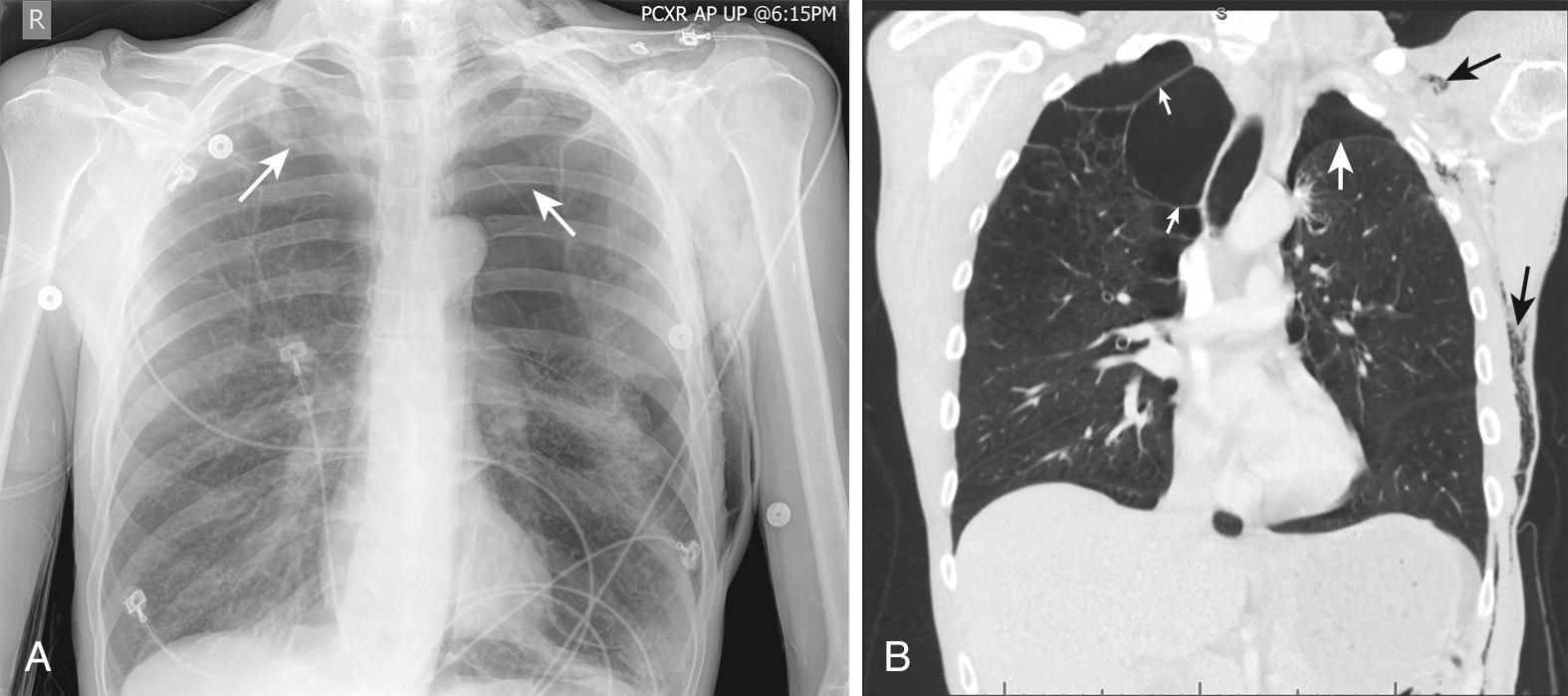
It is difficult to accurately predict the size of a pneumothorax on plain radiographs. Greater accuracy in predicting size can best be accomplished with a CT scan. With a tension pneumothorax, the chest radiograph reveals lung collapse, a depressed hemidiaphragm on the affected side, and a shift of the mediastinum and trachea to the opposite side (see Fig. 10.4 ). Keep in mind, with a bilateral pneumothorax, a mediastinal shift may not be seen.
The gold standard for diagnosis is a thoracic CT scan, which can even detect a pneumothorax that is not easily visible on a plain radiograph. CT scans of the chest are much more sensitive than plain radiographs in detecting hemothorax and pneumothorax. They are also more accurate for estimating the size and other characteristics of a pneumothorax (see Figs. 10.1, 10.4, and 10.8 ). CT scans are not routine for the diagnosis of a pneumothorax, but are more useful for hemothoraces and other fluid collections. They also offer invaluable information on the cause of such abnormalities. A CT scan may be useful when the diagnosis is unclear or when looking for small amounts of pleural fluid. CT scans are particularly helpful in determining whether an empyema is loculated or draining successfully. Approximately 10% of trauma patients with normal findings on a chest radiograph will demonstrate a small hemothorax or pneumothorax. The clinical significance of a small, previously undetected occult injury is probably not great, and it has been suggested that a small pneumothorax seen only on CT may be left untreated and simply observed in otherwise stable patients. Some patients with a pneumothorax seen only on CT may also safely undergo PPV without placement of a chest tube.
Ultrasound is useful in diagnosing both hemothoraces and pneumothoraces, and its use is reviewed in the Ultrasound Box .
To evaluate for pneumothorax, a high-frequency transducer should be used to ensure a high degree of resolution. In a supine patient the transducer should be placed on the anterior chest wall in the midclavicular line at approximately the second to third intercostal space ( Fig. 10.US1 ). The depth of the image should be adjusted until the ribs are seen as brightly echogenic (white) arcs with acoustic shadows behind them. The pleural line can be found just deep to the ribs and is represented as a horizontal, echogenic line ( Fig. 10.US2 ). In a normal lung, the visceral and parietal pleural layers are directly opposed to one another (save for a thin layer of pleural fluid). When the patient breathes in and out, the layers “slide” past each other to allow the lungs to expand. When this is viewed with ultrasound, the pleural line can be seen to slide back and forth with patient respiration. This is referred to as the “slide sign.” In cases in which this interface is disrupted (such as by a pneumothorax), the sliding is lost. When these patients are evaluated with ultrasound, the pleural line will be seen as a static echogenic line that does not change with respiration. Although the slide sign carries significant sensitivity for ruling out a pneumothorax, other secondary confirmatory findings should be sought as well.
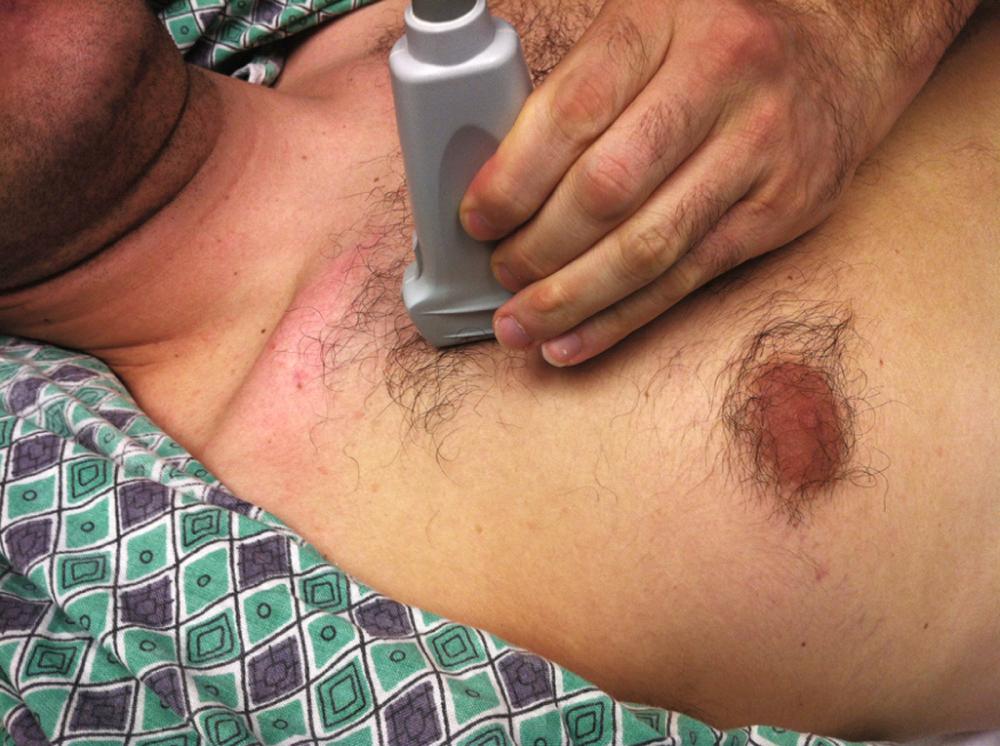
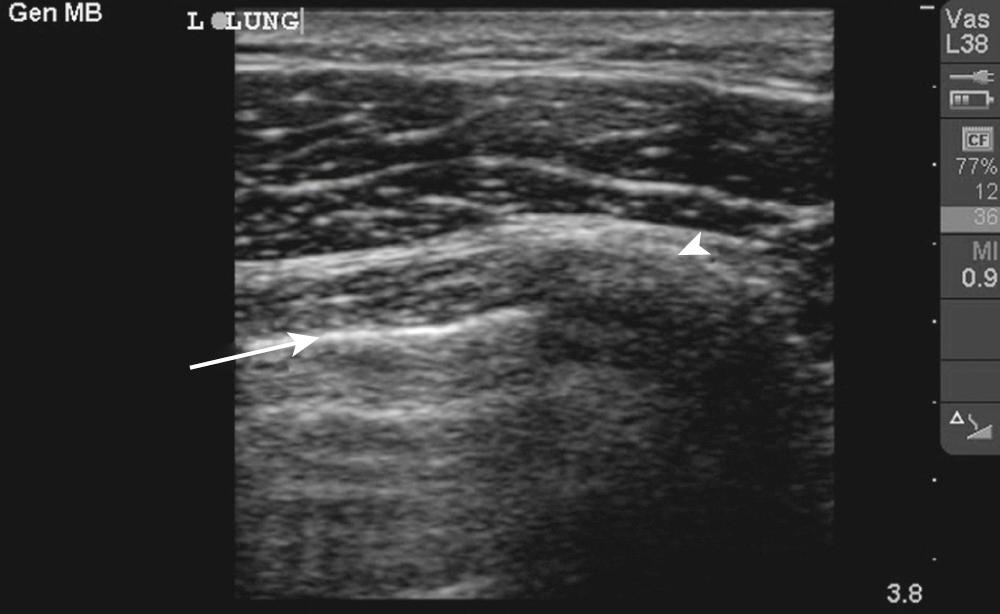
Comet-tail artifacts may be seen in a normal lung. These are hyperechoic vertical lines that extend deep to the pleural interface ( Fig. 10.US3 ). Typically, they will be seen in small numbers in a normal lung. Patients in whom a pneumothorax is present are noted to lack comet tails because this artifact arises from the normal pleural interface, which is disrupted. The presence of comet tails may be used by the sonographer to further rule out a pneumothorax.
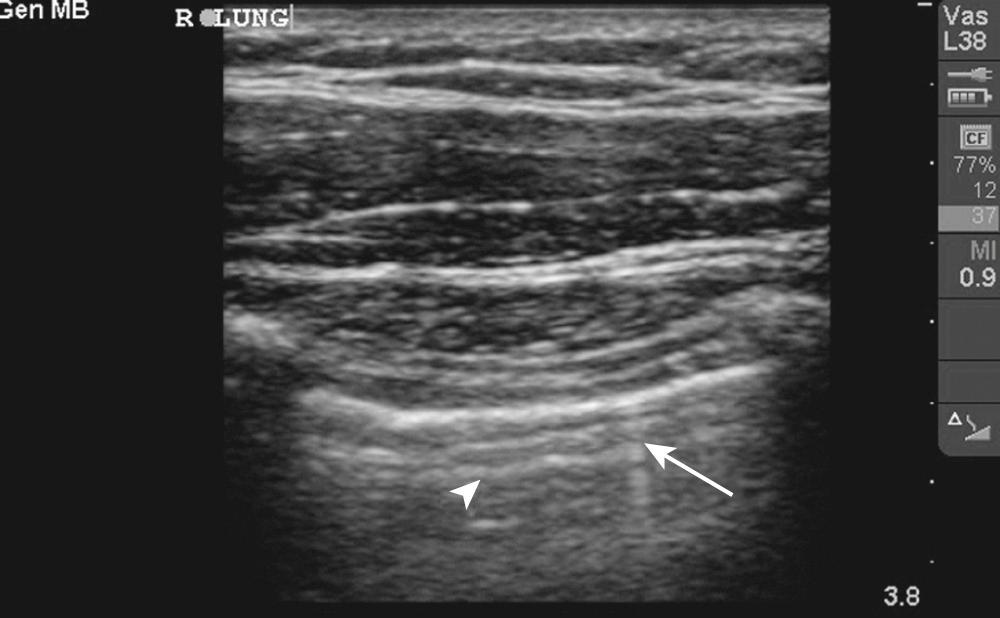
Motion mode (M-mode) may also be used to further evaluate for the presence of a pneumothorax. M-mode is used to evaluate objects in motion and plots a linear representation of motion on screen. Objects that move toward the surface (or toward the transducer) are represented by an upward deflection. Objects that move away from the transducer are represented by a downward deflection. Objects that are not in motion are represented by a solid line.
In a normal patient, the pleura will slide back and forth as the patient breathes. Because this motion is neither toward nor away from the transducer but instead is parallel, the motion will be seen as a series of hazy lines deep to the pleura. The overlying soft tissue is not in motion and will be seen as a series of clear, flat lines. This typical appearance is described as the seashore sign ( Fig. 10.US4 ).
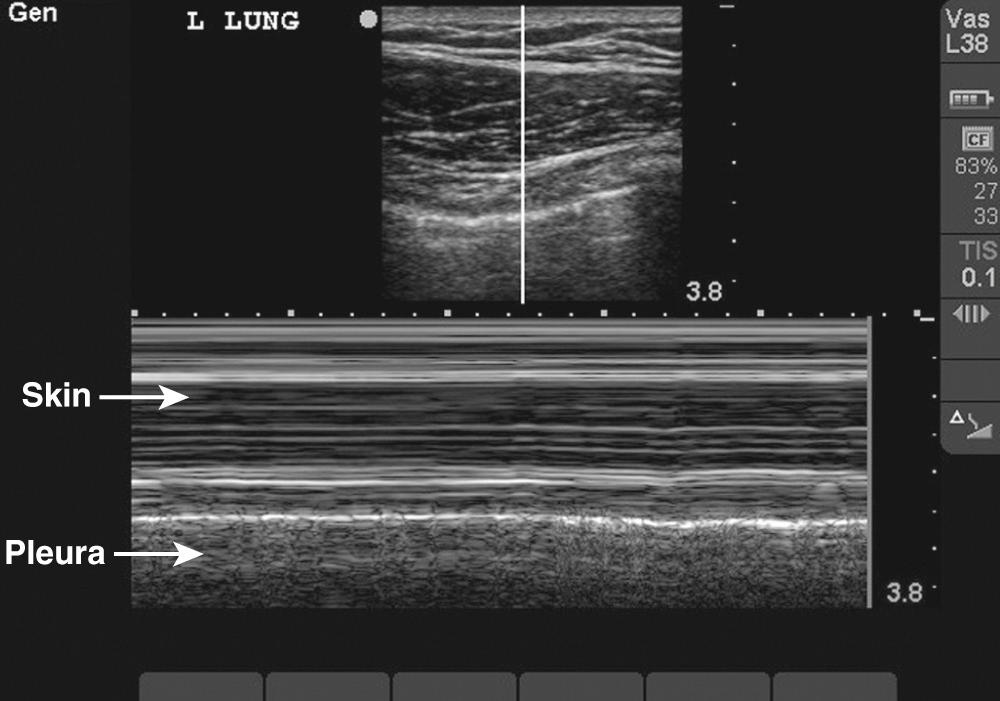
In patients in whom a pneumothorax is present, no motion is detected by ultrasound. Therefore the M-mode tracing will show clear, flat lines throughout the frame. This is referred to as the stratosphere or bar code sign ( Fig. 10.US5 ).
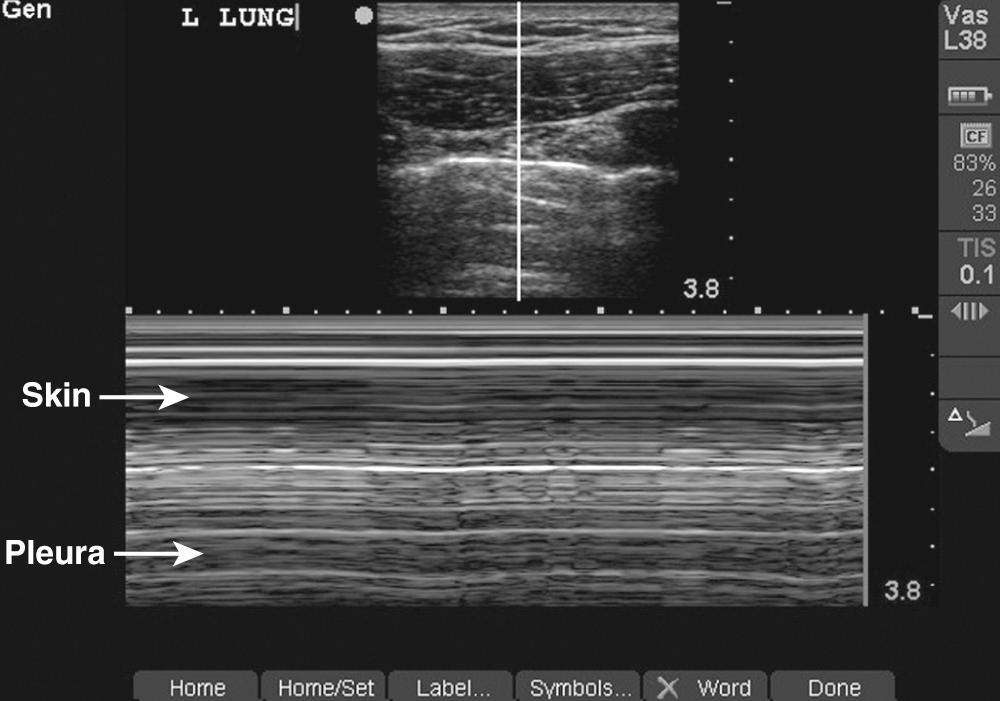
Thoracic ultrasound is a useful tool at the bedside to rapidly assess the lung fields. This includes the ability to assess the pleural space, diagnose pleural and lung parenchymal abnormalities and guide pleural-based procedures, including thoracentesis with or without catheter placement, and evaluation of placement for tube thoracostomy. Thoracic ultrasound has several advantages over standard chest radiographic imaging, including absence of radiation, portability, real-time imaging, and the ability to perform dynamic imaging. Sensitivity of lung ultrasound in the detection of pneumothorax is higher than conventional chest radiography. Thoracic ultrasound is considered superior in the detection and characterization of pleural effusion, and provides an advantage for the guidance of bedside pleural interventions. Additionally, bedside thoracic ultrasound is helpful in differentiating between consolidation, atelectasis, and effusion, all of which can appear as an opacity or “white out” on chest radiograph. Ultrasound can also be used to evaluate chest wall pathology.
Lower-frequency probes with smaller footprints, such as the phased-array probe, should be used for the evaluation of pulmonary and pleural pathology as the probe can allow for scanning between rib interspaces. For chest wall structures, changing from the 3.5 to 5 MHz phased-array probe to the linear probe with a frequency of 7.5 to 10 MHz will provide better visualization. Additionally, the linear high-frequency probe is better suited for evaluation of the pleural line, which is discussed later.
The normal pleura appears as an echogenic line between the chest wall and the air-filled lung. Lung sliding, which represents the visceral pleura moving against the parietal pleura, is a key finding in a lung without a pneumothorax. When air separates the two pleural layers, as in a pneumothorax, the movement disappears.
There are two main types of lung artifacts caused by air-tissue interfaces that are commonly observed, A-lines and B-lines. Horizontal artifact, or A-lines, are echogenic lines between rib shadows that are observed in normal lungs. B-lines arise at the border between aerated and compressed lungs. They are often described as comet-tail and are characteristic in that they spread to the edge of the screen without fading, move synchronously with the lung during respiration, and tend to erase A-lines. Multiple B-lines are often termed lung rockets and are pathologic.
Thoracic ultrasound can be an integral part in the evaluation of pneumothorax in a variety of situations. Examples include patients with chest trauma, evaluation for postprocedural iatrogenic pneumothorax, patients presenting with undifferentiated shortness of breath, hypoxia or chest pain, and following chest tube placement to assess resolution of pneumothorax. When evaluating for pneumothorax the patient should ideally be in the supine position for visualization of the lung apices. The probe indicator should be pointed cephalad at approximately the third-to-fourth intercostal space between the parasternal and midclavicular line. The probe is moved progressively toward the lateral chest, checking for lung sliding at different locations. Air will first move to the most superior part of the hemithorax, which in the supine patient, corresponds to the lung apices. The evaluation of pneumothorax should focus on observing for the presence of four sonographic artifact signs: lung sliding, including by M-mode sonography, B-lines, the lung pulse, and the lung point sign. The lung point sign is the most specific sonographic sign for pneumothorax and occurs when the lung intermittently comes into contact with the chest wall during inspiration. This represents the edge of the pneumothorax. The presence of a lung point is 100% specific for ruling in pneumothorax. Lung pulse describes the vertical movement of the pleural line synchronous to the cardiac rhythm and is caused by transmission of heartbeats through the lung.
Furthermore, thoracic ultrasound can be advantageous when evaluating the need for a pleural procedure and during the performance of this procedure. Blind insertion of a chest tube can result in significant complications in a patient with pleural adhesions from prior infections, pleurodesis, or pulmonary surgery. Guidance by ultrasound can help mitigate the risk of complications.
Ultrasound-guided thoracentesis, with or without subsequent placement of the drainage catheter, can be performed either by static or dynamic technique. Placement of tube thoracostomy is typically performed by static technique (or simply by landmark) after the diagnosis has been made and evaluation of the previously mentioned potential complications completed. Static ultrasound guidance identifies the intercostal spaces, pleura, and effusion, as well as the best angle of approach. The skin is then marked on the patient, the probe is removed, and the procedure carried out the same way as during landmark thoracentesis or tube thoracostomy. The examiner may also choose to observe diaphragmatic excursion through several cycles to avoid selecting a location where the instrumentation occurs too close to the diaphragm, potentially resulting in laceration.
Thoracic ultrasound is considered superior to chest CT in visualizing stranding and septations in complex pleural effusions. The ability to detect such findings may prove useful as they can predict difficulty with tube drainage. Additionally, distinguishing large bullae from a pneumothorax can be very challenging, as plain radiograph of the chest may be inadequate to make the diagnosis. Making the correct diagnosis is critical as the management approach for these two entities varies significantly. Whereas CT of the chest remains the diagnostic modality of choice for characterization of large bullae, there are case reports in the literature where thoracic ultrasound was used to correctly differentiate bullae from pneumothorax. Specifically, the comet-tailing phenomenon of the movement of the lung tissue against the pleura during respiration was noted to be present in bullous disease but absent in pneumothorax.
Tube thoracostomy is by far the most common treatment for all types of pneumothoraces, but controversy exists over the treatment of small traumatic and spontaneous primary pneumothoraces. Treatment should address several basic issues: (1) removal of air, (2) preventing further air accumulation, (3) healing the injury that caused the initial accumulation, (4) promoting lung reexpansion, and (5) preventing or limiting reoccurrences. The American College of Chest Physicians has developed useful guidelines for the management of primary and secondary spontaneous pneumothoraces ( Box 10.1 ).
Become a Clinical Tree membership for Full access and enjoy Unlimited articles
If you are a member. Log in here